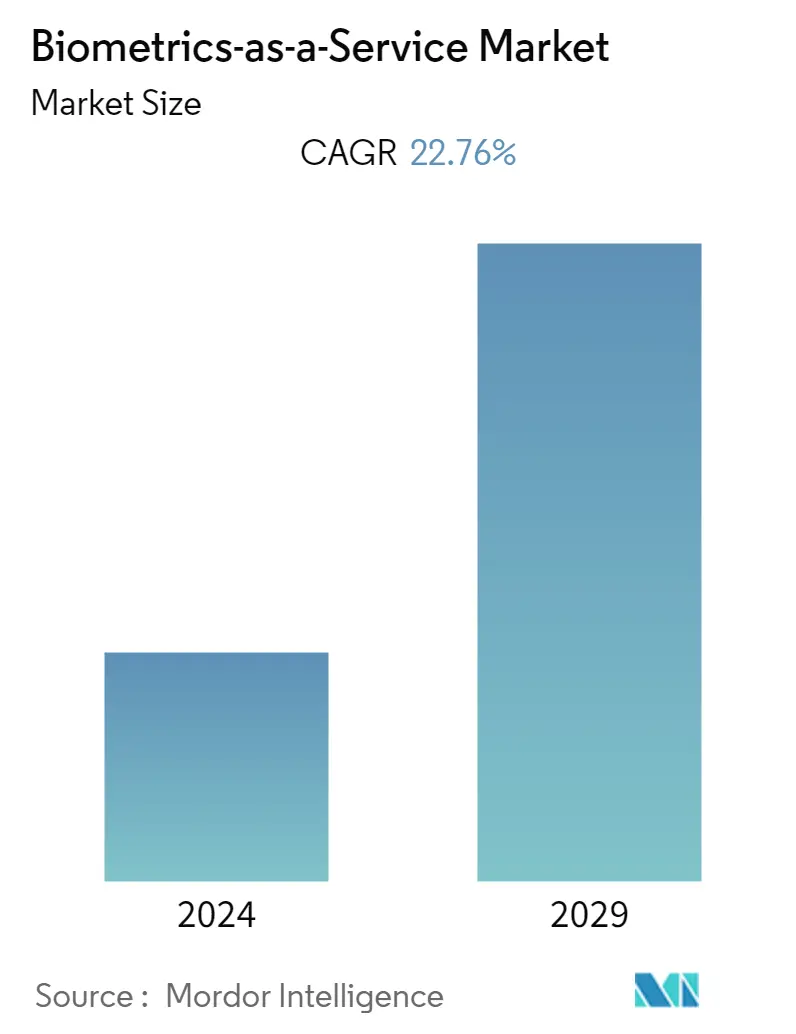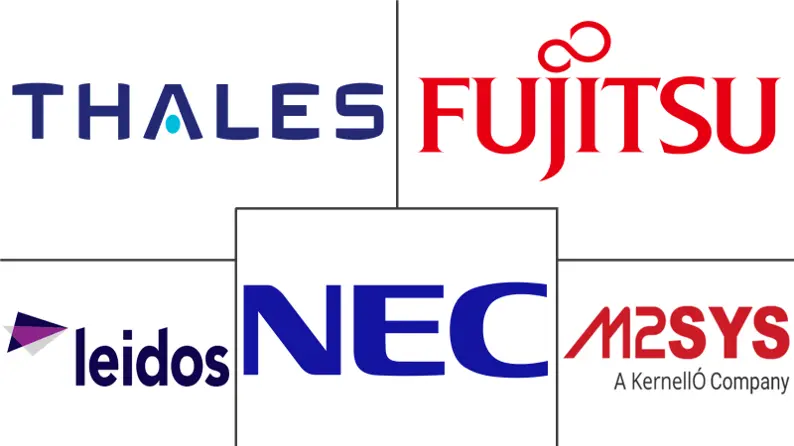Market Size of Biometrics-as-a-Service Industry

| Study Period | 2019 - 2029 |
| Base Year For Estimation | 2023 |
| CAGR | 22.76 % |
| Fastest Growing Market | Asia Pacific |
| Largest Market | North America |
| Market Concentration | High |
Major Players
*Disclaimer: Major Players sorted in no particular order |
Biometrics-as-a-Service Market Analysis
The biometrics-as-a-service market was valued at USD 4.75 billion in 2020 and is expected to reach USD 16.03 billion by 2026, registering a CAGR of 22.7% during the forecast period from 2021 to 2026. The global biometrics demand is anticipated to develop at a significant growth rate, owing to the rising number of terrorist activities, the increasing theft activities about crucial data, and information that have raised concerns regarding national security. Significant factors, such as growth in the e-passport program, government support, and extensive use in criminal identification, are expected to drive the market's growth over the forecast period majorly. The recent COVID-19 outbreak is also becoming an emerging driver for contactless biometric solutions.
- Organizations across various sectors, where security remains the primary concern, are investing heavily in their security systems, focusing on access control systems. The defense, law enforcement, and government institutions are some of the prominent users of this technology. Moreover, the soaring need to strengthen national security augmented the growth of these systems, globally. Iris recognition is used in different countries for a wide range of purposes, including passport-free automated border crossings. The biometric-as-a-service solution can be leveraged to not only tie disparate identity information across the business but also enable the integration of different types of biometrics as best suited to particular business needs and risk levels.
- One of the key trends witnessed in the market studied is a model shift in business discourse toward more privacy and fewer security threats. The end-users are increasingly expecting for integrated solutions, rather than depending on traditional methods. Consumer biometric applications have expanded rapidly over the recent years, with increased adoption of mobile devices. The consumer electronics sector is dominated majorly by security and access control devices, owing to the approval of biometric systems. Thus, it is supporting the growth of the market. For instance, WhatsApp, a popular messaging app, launched an additional privacy measure on the Android platform. The company claims that users will soon be able to secure their accounts in the form of biometric authentication through fingerprint sensors.
- Integrating biometrics with the cloud, which is the main focus area for vendors presently, enables cloud - enhanced capabilities and technologies to be assimilated on the entire biometrics' infrastructure of a service provider. For instance, in July 2019, SkyBiometry updated the version of its cloud-based face detection and recognition algorithm that included significant enhancements that make the algorithm much more accurate and allow for a broader range of facial attributes in the detection process. Further, Fujitsu partnered with ImageWare Systems (IWS) to provide Biometric-as-a-Service solutions. With a combination of Fujitsu's cloud Infrastructure-as-a-Service (IaaS) and Software-as-a-Service (SaaS), along with IWS' biometrics authentication technology, enterprises can be prepared for a BYOD workplace environment and security-enhanced services for mobile transactions.
- The COVID -19 outbreak and the nationwide lockdown have impacted many industries around the world, so does the studied market. Due to the recent COVID-19, the biometric market has witnessed a significant shift in the adoption pattern. The COVID-19 has developed a massive space for contact-free sensing solutions. Although the market is seeing a decline in touch-based technologies, the touchless technologies are now flooding the market. The trend can be seen across various end-users like offices, hospitals, airports, and secure locations that rely on fingerprint readers, card access, or manual processes. The significantly growing adoption of non -contact biometric attendance in these applications is also driving the overall market. In the last 3 - 4 months, the market has witnessed a massive decline in fingerprint recognition as many government agencies are claiming that there is a risk of infection via these commonly touched surfaces.
Biometrics-as-a-Service Industry Segmentation
Biometrics-as-a-service is a software that is owned and managed remotely by various providers. Biometrics technology is used to identify and authenticate people with the help of their biological and behavioral characteristics. However, biometrics-as-a-Service uses the established benefits of software-as-a-service. The study covers the popular existing biometric-as-a-Service application, scanner type, end-user industry, and geographical analysis throughout the forecast period.
| By Application | |
| Site Access Control | |
| Time Recording | |
| Mobile Application | |
| Web and Workplace |
| By Scanner Type | |
| Fingerprint Recognition | |
| Iris Recognition | |
| Palm Recognition | |
| Facial Recognition | |
| Voice Recognition | |
| Other Scanner Types |
| By End-user Industry | |
| Government | |
| Retail | |
| IT and Telecom | |
| BFSI | |
| Healthcare | |
| Other End-user Industries |
| Geography | |
| North America | |
| Europe | |
| Asia Pacific | |
| Latin America | |
| Middle East and Africa |
Biometrics-as-a-Service Market Size Summary
The biometrics-as-a-service market is experiencing robust growth, driven by increasing concerns over national security, data theft, and the need for enhanced security measures across various sectors. The market is witnessing a significant shift towards contactless biometric solutions, accelerated by the COVID-19 pandemic, which has highlighted the importance of touchless technologies in maintaining hygiene and safety. Key drivers of market expansion include the growth of e-passport programs, government support, and the extensive application of biometrics in criminal identification. Organizations in defense, law enforcement, and government sectors are major adopters, investing heavily in access control systems to bolster security. The integration of biometrics with cloud technologies is a focal point for vendors, enhancing the capabilities and efficiency of biometric systems.
In the retail industry, biometrics is increasingly used for access control and to enhance customer experience through data-driven insights. As brick-and-mortar retailers expand their online presence, the need for securing customer data becomes paramount, driving the adoption of biometric solutions. The market is characterized by a competitive landscape with key players like Thales Group, Fujitsu Limited, and NEC Corporation leading the charge. These companies are focusing on innovation and strategic partnerships to strengthen their market position. The market remains fragmented, with numerous players vying for market share, underscoring the importance of continuous product and service innovation to maintain a competitive edge.
Biometrics-as-a-Service Market Size - Table of Contents
-
1. MARKET DYNAMICS
-
1.1 Market Overview
-
1.2 Industry Attractiveness - Porter's Five Force Analysis
-
1.2.1 Bargaining Power of Suppliers
-
1.2.2 Bargaining Power of Consumers
-
1.2.3 Threat of New Entrants
-
1.2.4 Threat of Substitute Products
-
1.2.5 Intensity of Competitive Rivalry
-
-
-
2. MARKET SEGMENTATION
-
2.1 By Application
-
2.1.1 Site Access Control
-
2.1.2 Time Recording
-
2.1.3 Mobile Application
-
2.1.4 Web and Workplace
-
-
2.2 By Scanner Type
-
2.2.1 Fingerprint Recognition
-
2.2.2 Iris Recognition
-
2.2.3 Palm Recognition
-
2.2.4 Facial Recognition
-
2.2.5 Voice Recognition
-
2.2.6 Other Scanner Types
-
-
2.3 By End-user Industry
-
2.3.1 Government
-
2.3.2 Retail
-
2.3.3 IT and Telecom
-
2.3.4 BFSI
-
2.3.5 Healthcare
-
2.3.6 Other End-user Industries
-
-
2.4 Geography
-
2.4.1 North America
-
2.4.2 Europe
-
2.4.3 Asia Pacific
-
2.4.4 Latin America
-
2.4.5 Middle East and Africa
-
-
Biometrics-as-a-Service Market Size FAQs
What is the current Biometrics-as-a-Service Market size?
The Biometrics-as-a-Service Market is projected to register a CAGR of 22.76% during the forecast period (2024-2029)
Who are the key players in Biometrics-as-a-Service Market?
M2SYS Technology - KernellÓ Inc., Fujitsu Limited, NEC Corporation, Thales Group (Gemalto NV) and Leidos Holdings Inc. are the major companies operating in the Biometrics-as-a-Service Market.

